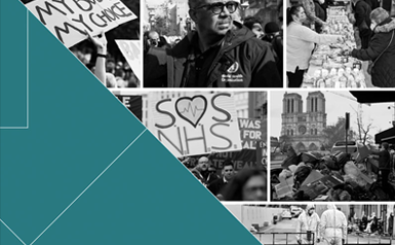Imagine a world in which an extremist preacher sitting in the desert in Syria could preach hatred to 5 million potential recruits simultaneously. Through virtual reality, the would-be jihadis could feel the wind and dryness of the purifying desert on their skin, alongside the rhetoric of glory in this world or the next.
Consider a time when there is no cash and funds skulk across borders, untraceable, funding terror cells anywhere. Malevolent forces could hack into your home via your computer or even your television. Cyber-terrorists can hack into driverless cars to create mass casualties.
These scenarios are not too far away; some are with us today. The so-called Islamic State (IS) is reportedly experimenting with its own driverless cars. It already uses social media and digital channels to recruit, propagandise and intimidate. IS has embraced digital warfare in a far more effective way than any terror group that has come before it.
Increasingly over the past decade, wars have been fought online as well as offline. This trend will only grow due to the speed of technological change and easier access to a shrinking world.
Add the possibility of ballooning levels of unemployment caused by automation in “the fourth industrial age”, accompanied by growing anger and alienation, and that will create a lethal cauldron from which we can expect future crises to emerge.
Over the next twenty years, the means for terror groups to stoke fear, inspire recruits and generate chaos will be limited only by their creativity. Technology will be central to future global crises. Terrorists and aggressive states see tech’s potential to offer affordable, achievable weapons of mass destruction.
Already, fifteen-year-old hackers can commandeer millions of computers from their dark suburban bedrooms, bringing down corporations and doing violence to the competence of, and confidence in, all governments. Some of these individuals are part of a global hacking movement driven by good old-fashioned counter-cultural resistance. We live in an increasingly noisy “post-truth” era, in which teenage hackers consider business as bad, governments as corrupt and the “house” — as they view the gambling excesses of global capital markets — skewed toward the richest 1 per cent.
Computing power is growing so fast and the hacking tools are so easy to find that this movement poses a very real risk to future stability. If it remains true that computing power doubles every two years, then in twenty years our current technological capabilities will be about 8,000 times more powerful. Cryptography will be many orders of magnitude tougher to break. The same tools that protect our security also pose a real threat.
Terror groups will ride these trends too. Front of stage, we will see greater sophistication in the use of social media platforms — the visible manifestation of technology as a terror weapon.
The marketing skills consumer brands use to “tell stories” will increasingly be adopted by extremist organisations. Communication will take the form of much visually richer video and images, used to spread fear and brag about successes. Messages could be targeted to social feeds, seeking out vulnerable individuals or groups, or intimidating policymakers directly. In a parallel of targeted advertising, terror groups will pick off audiences and deliver specific tailored messages. Like media organisations, they will move from broadcasting to narrow casting.
A black flag flying on the public website of the U.S. State Department is simply a toe in the water. In October, a young man from Kosovo was arrested in Malaysia on charges of stealing the personal data of more than 1,000 U.S. military personnel and federal employees — and handing over the information to IS for use in targeted attacks. Such incidents are likely to become much more commonplace.
Meanwhile, backstage will be dominated by encrypted communication and digital currencies. The “dark wallet” and the digital ledger were invented by financial institutions to ease capital flows and protect privacy. The cryptography used to create such products may, however, allow terrorist groups to elude state surveillance.
In twenty years’ time, when many countries will be cashless, relatively unsophisticated groups will be able to smuggle money with ease. Nobody yet knows what threats this might present to capital markets, financial institutions and the global economy.
In hardware, technological advancements — robotics or artificial intelligence — are also potential weapons that may be wielded to spark conflict. Virtual and augmented reality offer the most potent recruitment or intimidation tools the world has ever seen.
Within five years, most children from industrialised nations will have a form of virtual reality (VR) in their bedrooms. VR’s powerful immediacy can be used by groups like IS to bring followers closer to their perverted version of the world. The experience will be more impactful and more intoxicating to those vulnerable to the message.
A fully immersive sensory experience will result in a far more rapid assimilation of information, a boon for organisations that seek recruits through brainwashing. The optic nerve processes data at 8 megabits per second. But we use just a fraction of this at 1 kilobit per second when we are reading on the screen.
With VR, converts won’t be made in prisons or prayer groups, but in bedrooms.
Of course, technology is an enabler; when it comes to terrorism, it is human beings we should be more worried about. This goes to the heart of the biggest risk we face with respect to future crises — millions of disenfranchised, disaffected, unemployed people angry at the growing opportunity gap between the super wealthy and everyone else. The Arab Spring was driven by this phenomenon, and the main conflicts over the next twenty years will be too.
A 2013 study by Michael Osborne and Carl Benedikt Frey, which looked at over 700 different job types, found that almost 50 per cent of total U.S. employment was at risk of substitution by robot or computer. That is about 60 million jobs. If the 1990s were about squeezing out the middle of the job market, the future will be about squeezing almost everywhere else, unless your work involves personal and direct interaction with other human beings. New types of jobs will be created too, but many economists predict that government share of GDP will have to go up to pay for welfare as we experience racing levels of unemployment.
Capital is rising in GDP terms while labour is falling, most dramatically in the U.S., where corporate profits make up nearly 10 per cent of GDP. Future businesses will be much more like Instagram — which had only thirteen employees when it was acquired by Facebook for $1 billion — than like Kodak, whose workforce once numbered 145,000 people.
The risk of civil disruption will increase as fewer people find rewarding employment. Large groups of unemployed, tech-savvy youth will look to get even with society. How will we help them? How will we disentangle idealism from violent extremism?
Facing such complexity, any response will require a sophisticated and subtle hand to balance new restrictions with freedoms, particularly the right to free expression. We must prepare for enemies of democracy to take the fight online. But we must be careful to avoid doing their work for them by curbing freedoms in the digital world that earlier generations won on bloodier battlefields.
This essay originally appeared here as part of International Crisis Group’s ‘Future of Conflict’ collection of essays:- a series of 20 essays forecasting the “Future of Conflict” to mark the 20th anniversary of International Crisis Group. International Crisis Group is an Edelman client.



